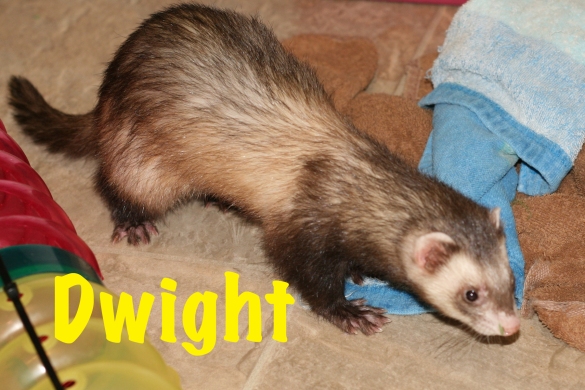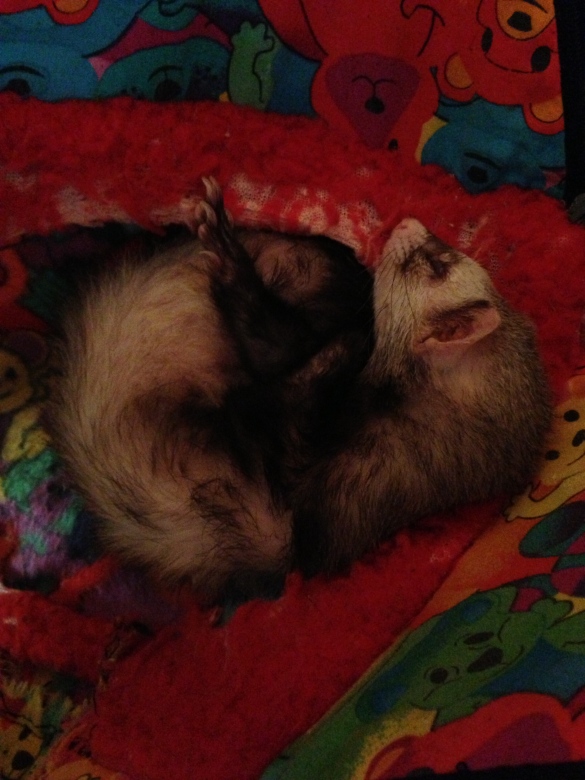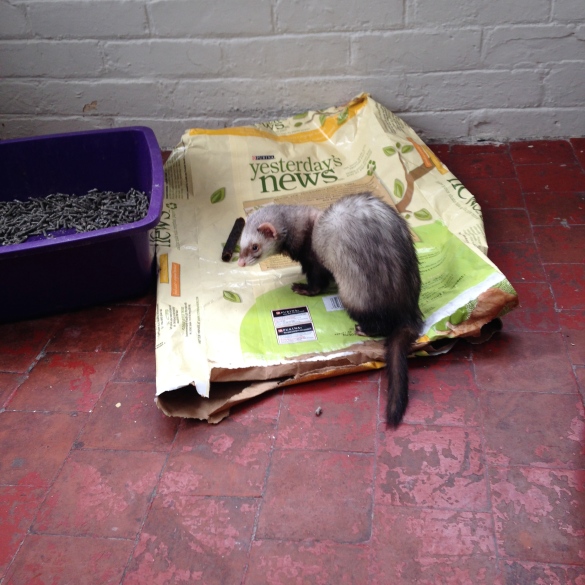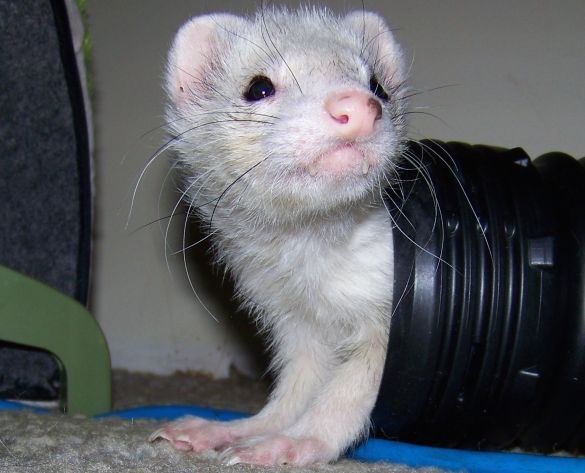While you may see your ferret grooming itself, that doesn’t let you off the hook! There are a few things you need to do as a responsible ferret owner to keep your ferret looking, feeling and smelling good!
Bathing
The most important part of your ferret’s bathing routine is to not over do it, ferrets that bath too often end up with a stronger odor. Over bathing can wash away the oils from your ferret’s fur, which in turn will dry their skin out. When a ferret’s skin dries out it over-produces the oils and the poor ferret gets itchy, which all adds up to one stinky fuzzbutt.
Basically you should only be washing your babies at most twice a year. Bath your ferret in the Spring when he starts shedding his winter coat and in the Fall when he is shedding his summer coat. Your ferret can splash a round in the tub or water dish every day so long as there is no soap involved.
To keep smells down make sure the ferret’s environment is nice and clean; scoop litter daily, dump litter weekly, change the bedding every second or third day and clean entire cage monthly (or as needed, my boys are slightly messier so I do more often). Washing down your cage floors with a vinegar solution helps deodorize and sanitize.
Shampoo options vary, there are even quite a few ferret specific shampoos. Although baby shampoo works most shampoos meant for adults aren’t pH balanced properly for ferrets. Conditioners are not required but they can help the ferret’s skin from drying out, a good option is to use conditioner in winter.
Tips for ferret bath time; make sure water is just over room temperature (or slightly warmer), a ferret’s body temperature is ~ 102 degrees Celsius. At room temperature the ferret will find it cold. Some ferrets enjoy a bath full of water, others like to be able to walk in the tub and some others like ‘showers.’
Ear Cleaning
Much of the odor on a ferret is actually their ear wax, you should clean a ferrets ears every two weeks. Ear wax is red, brown or gold in colour, if you see something else contact your vet (black ear wax can be a sign of ear mites).
To clean your ferret’s ear;
1. Warm the solution
There are many different options for ear cleaning ‘solutions’ including oils or liquid (I’m not sure on the oil option as they generally say to stay away from oils for ferrets). Purchase the alcohol free ear cleaning solution from your vet as your best choice.
2. Scruff
Scruffing a ferret is identical to scruffing a dog or cat – the extra skin on the animal’s neck behind their head where a mommy or daddy would use to carry their babies. Generally this will make your ferret yawn – which is pretty adorable.
3. Put a few drops of solution into the ferret’s ear
This will help loosen the ear wax
4. Gently massage the base of the ferret’s ear
This is to work the solution inside the ferrets ear
5. Moisten a cotton swab with more solution and clean the outer ear by beginning at the base of the ear
A ferret’s ear canal is shaped like an L.
6. Continue using a moistened cotton swab until the ear wax is gone, then switch to a dry swab to dry the ear out
7. Follow up with a treat
Left untreated ear mites can cause many health issues including deafness
Here are some more step-by-step guides; Wikihow, WeaselWords, FerretNews
Nail Trimming
It is very important to keep on top of trimming your monster’s nails – when they become too long they can catch on things. Sometimes in an attempt to pull the nail free, your ferret can pull it’s nail right off! Needless to say that is extremely painful and bloody!I have seen my ferrets get their nails caught then go straight into the alligator roll – this can actually cause a ferret to sprain something.
Tools to clipping nails;
1. Small kitten sized nail clippers
Human nail clippers will not work, ferrets have very small nails that can easily be cut too short, they are also thin enough that you can crush the nail if the blade is not sharp enough.
2. Corn starch or Styptic powder
Accidents happen so be prepared for such. The benefit of purchasing Styptic powder is you know it is sterile, but if you are worried about costs Corn starch works just as well to stop bleeding when nails are clipped too short. Styptic powder will sting, while the cornstarch doesn’t and is what the shelter uses with very good results.
3. Ferret Lax (hair ball remedy) or Salmon Oil/Olive Oil/Flax Oil/Canola Oil -which ever oil product you are using.
These are used to distract the ferret while you clip their nails. I generally place my ferret on their back on my lap, put the Ferret Lax or Oil on their tummy and clip their nails while they lick away.
Where to clip: if you look at a ferret’s nail it has a small red dot called the quick and from there out is clear or cloudy (rarely do they have dark nails, often they are dirty though). It’s best to cut as close as you can to the quick, for stronger nails this is easier, for softer you might have to keep a little more room between.
If you find your ferret absolutely hates having their nails being cut there are a few options; my youngest, Radish, I cut two toes at a time. Sometimes that means he goes first, he takes a break while I cut the other ferret’s toes and finish him off at the end. At times Radish cannot stand even that so his back legs I have to do the next day.
Another option for the difficult ferrets is wrapping them in a towel to keep them stationary without hurting or causing more stress. The towel method works by rolling it around the ferret’s body, keeping one paw and their head loose, while a helper distracts your ferret with their oil treat. *This only works on one ferret in a thousand!
Brushing Teeth
This takes getting used to, be gentle and remember this will probably not be your best bonding moment. You can always ease into this by scruffing and touching your ferret’s teeth for a few seconds. Here’s some general steps to follow, but the best is to figure out what works for each of your little monsters;
1. Wet the baby toothbrush or a baby washcloth and apply a small amount of paste (pet toothpaste, not human)
2. Scruff your ferret
3. Gently brush their teeth, strokes going with the teeth (i.e. top brush down, bottom brush up). Pay special attention to their back teeth as food can get stuck there and they might not notice it.
4. Ending with a treat, this helps with bitter feelings.
5. Now that StrixNB for dogs can be used off label for ferrets. Simply half the dosage. Offer your ferret one dish with regular water and one with the Strix added.
Other links describing teeth maintenance; PetFinder, PetsDotCom.
Ferrets that receive lots of soft treats (i.e. baby food, soft diets and duck soup) should have their teeth brushed weekly. For others generally twice a month is good.
You can also take ferrets to the vet – if you start to see greyish green spots this is a good indication that it is time to do this. Taking your ferret to the vet for a full cleaning (dental prophylaxis) should only be done every 2-3 years.


















